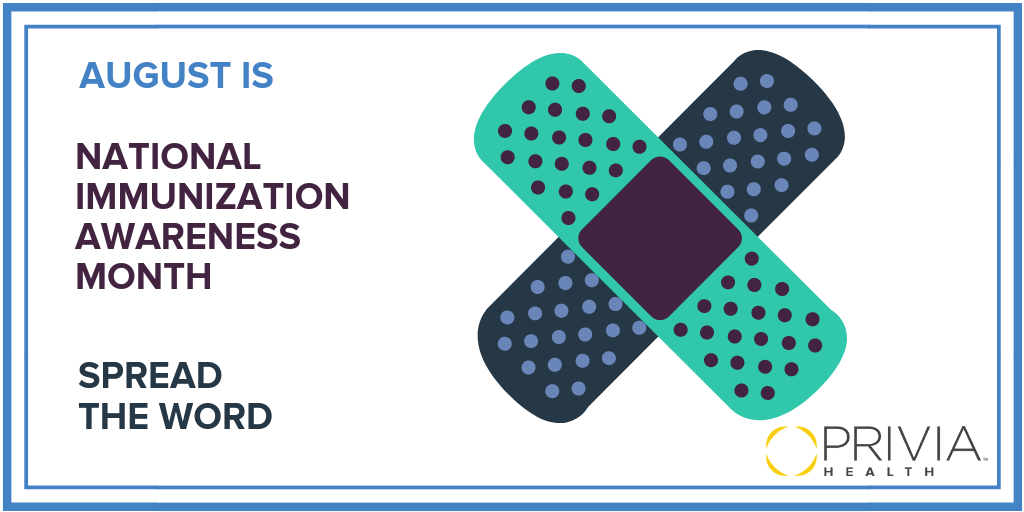by Samantha Frank
August is National Immunization Awareness Month (NIAM)! While vaccinations are certainly important every month of the year, August is dedicated to educating people about the importance of vaccination at all ages and highlighting how immunizations aid in disease prevention. This year, spreading this message is more crucial than ever before.
Why NIAM Matters More Now Than Ever
Earlier this year, the World Health Organization (WHO) declared “vaccine hesitancy” one of the top 10 threats to global health. The rate of immunization has declined in children ages 19–35 months and outbreaks of previously eradicated diseases in the United States, such as measles, have increased. There are a variety of reasons why people opt out of vaccinations, for themselves and for their children. However, providers have the power to clear up misconceptions about immunizations and raise awareness about the protection that they provide on both an individual and population level.
What Impact Can I Make?
According to WHO’s analysis of the vaccine hesitancy epidemic, healthcare professionals, especially those practicing within their own communities, remain the most trusted advisors and influencers of vaccination decisions. This gives providers the ability to make a tremendous impact on patients’ perceptions of vaccinations and help showcase why immunizations are critical to maintaining the health of individuals and communities. Various organizations, including the Centers for Disease Control and Prevention (CDC), have provided online toolkits and resources with tips on how to recommend immunizations to patients and build upon the momentum of NIAM for the remainder of August and beyond. Below are some of the CDC’s valuable guides.
What Are Some Tips I Can Use in My Personal Practice?
CDC’s suggestions focus on tailoring discussions about vaccinations to best accommodate the patients’ needs. The CDC urges providers to meet patients where they are in terms of knowledge of or hesitancy towards immunizations. They also emphasize the need for differentiating how the conversation is facilitated according to the patient’s age. For example, the CDC offers an interactive Adult Vaccine Assessment Tool that enables adults to answer 10 simple questions and receive suggested vaccinations based upon age, health conditions, occupation, and other factors. This engages and instills a sense of autonomy within the patient, while also providing a personalized list of vaccinations one might need to receive. Similarly, interactive materials, such as videos discussing vaccinations in children, help ease concerned or skeptical parents. Referring patients to these helpful resources is one way to spread awareness about the importance of vaccinations. You can even print copies of the CDC’s immunization infographics to advertise in your waiting room.
Why Should I Invest in This Cause?
Here’s the bottom line: more than 50,000 adults die from vaccine-preventable diseases each year. As physicians, you can impose small tweaks to workflows in your practice to get vaccination rates back on the rise. Increasing the accessibility to vaccinations by offering longer immunization clinic hours. Sharing personal anecdotes about how vaccinations have positively impacted your own life to personally appeal to patients is another tactic providers can use. Sometimes the smallest changes in your practice can make the biggest difference.
Help us promote National Immunization Awareness Month and advance these crucial conversations on social media by retweeting our ready-made tweet.
The @WHO listed “vaccine hesitancy” as one of the top 10 threats to global health.
Help us raise awareness this National Immunization Awareness Month.#healthcare #vaccines #globalhealth pic.twitter.com/PrMC5h1lVB
— Privia Health™ (@PriviaHealth) August 16, 2019
About the Author: Samantha Frank is a student at American University, where she is pursuing her major in public health. She is passionate about working with children, volunteering and community service, and writing about topics in healthcare. She is also a marketing and sales intern at Privia Health™.










Related Articles
How to Keep Your Patients From Skipping Mammograms
Kristin Schraa, MD, with Virginia Women’s Center shares how women’s health providers can encourage patients ...
3 Ways Healthcare Can Integrate Behavioral Health and Primary Care
Integrating behavioral health with primary care can lead to better patient outcomes — but how ...
How Can Physicians Support Postpartum Mental Health?
On average, 13 percent of mothers in the United States will develop symptoms of postpartum ...
Engaging Patients in Annual Mammograms
Studies show that a little over 66 percent of women aged 40 and older get ...
What Do Medicare-Aged Patients Want in Their Healthcare?
Within the next 20 years, 20 percent of Americans will be 65 or older. It ...
How Health Systems Grow Stronger With Privia Health
Discover how we helped Health First upgrade technology, align physicians, and accelerate toward value-based care. ...